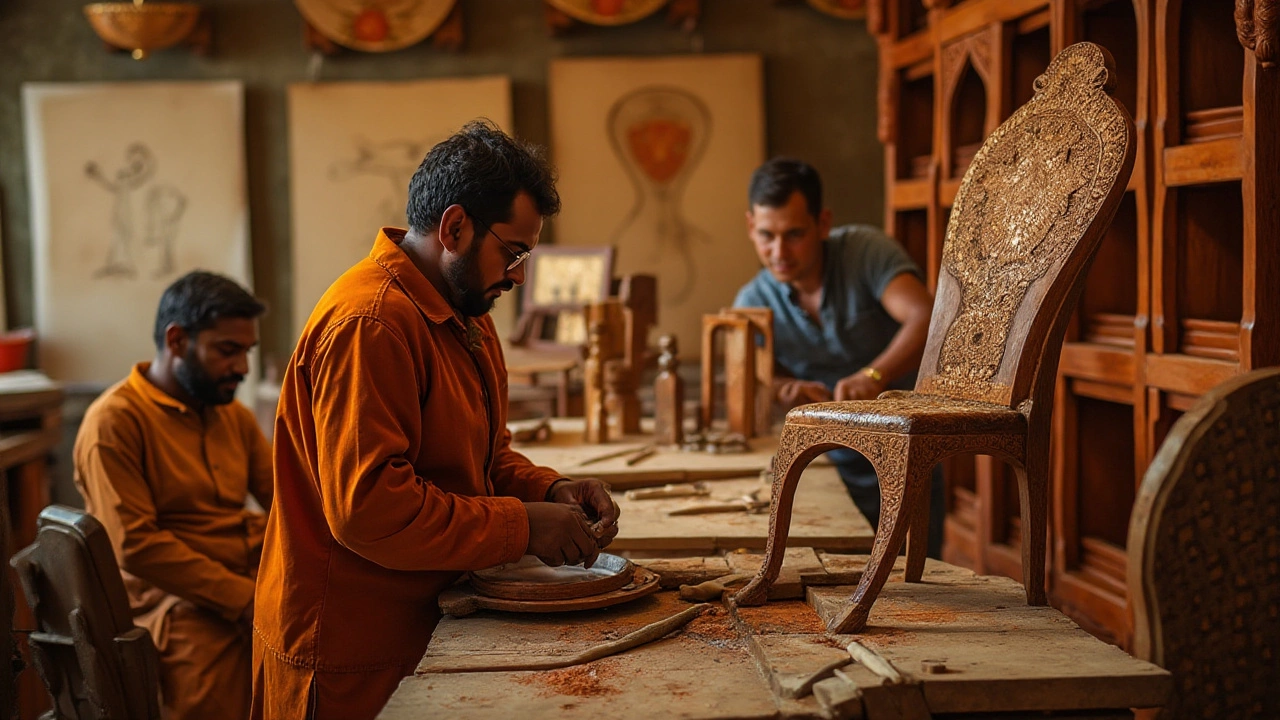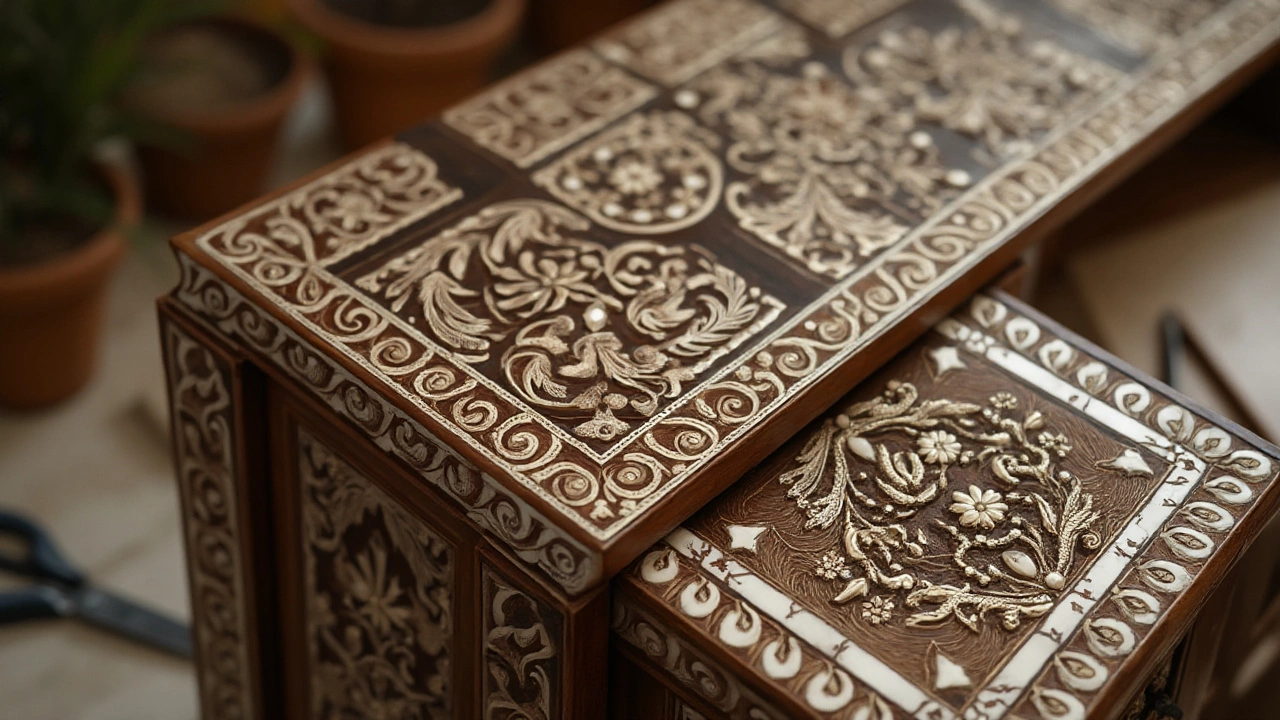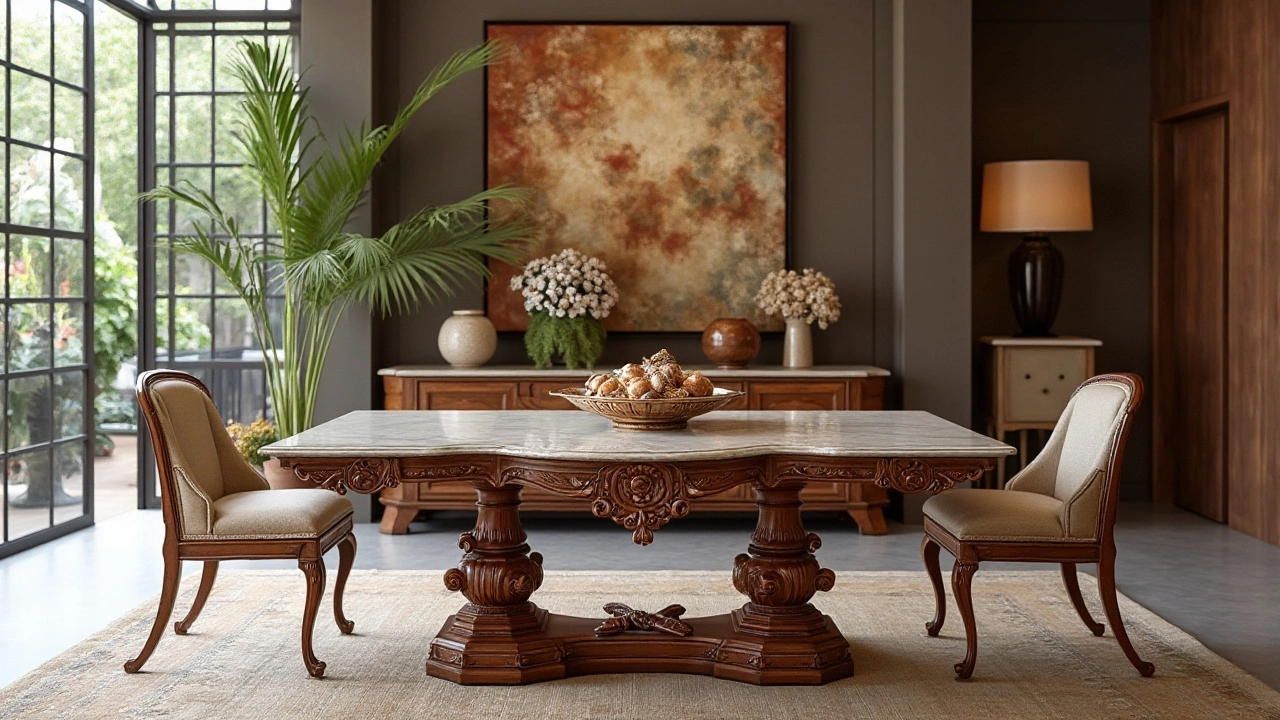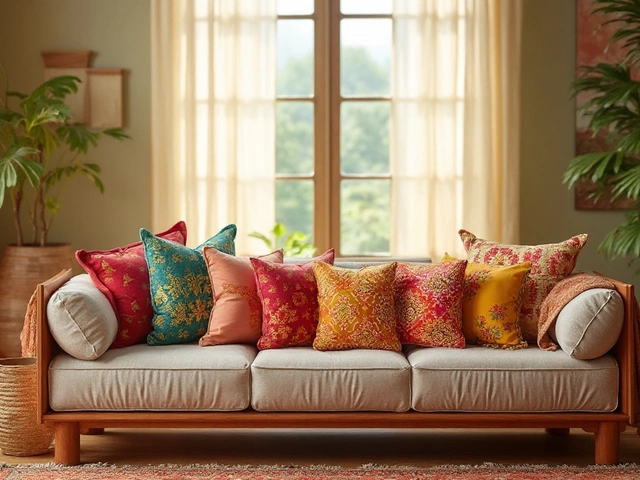
India's rich history of craftsmanship continues to thrive in its high-end furniture scene. This is where age-old techniques meet the modern aesthetic, resulting in furniture that's as diverse as the nation itself. Whether it's the charming elegance of carved wood or sleek, minimalist modern designs, Indian furniture makers are known for their impressive skills and commitment to quality.
Diving into the world of luxury furniture in India means exploring a variety of styles and techniques. Each piece tells a story, often combining traditional motifs with modern lines that cater to a global audience. As the market expands, sustainable practices and ethical production are also becoming pillars for many top-tier manufacturers, ensuring that beauty doesn't come at the expense of the planet.
With growing international interest, Indian furniture artisans are setting trends and raising standards. Anyone searching for distinctive and elegant furnishings will find themselves captivated by what Indian high-end furniture makers have to offer. Understanding what makes each brand unique and learning what to consider when making a choice will enrich your experience in selecting the ideal pieces for your space.
- Exquisite Craftsmanship and Traditional Techniques
- Notable Indian Furniture Brands
- Sustainable and Ethical Production
- Innovative Designs with a Cultural Touch
- The Global Appeal of Indian Furniture
- Choosing High-End Furniture: Tips and Considerations
Exquisite Craftsmanship and Traditional Techniques
India’s legacy of exquisite craftsmanship stems from centuries of tradition and cultural diversity that converge brilliantly in its furniture. From the Mughal era’s intricate carvings to the serene simplicity of the countryside, artisans have honed their skills through generations. It’s in the details where their mastery becomes apparent—meticulously carved embellishments, delicate inlays using precious metals and stones, and finishes that speak of hours of loving work. Imagine the fragrant scent of freshly carved rosewood filling a workshop or the rhythmic tap of a hammer setting bone inlays, evoking a connection between the artisan, their craft, and the natural world.
Traditional techniques such as hand carving, lacquerwork, and inlay continue to dominate the luxury furniture landscape in India. Each region boasts its unique style, like the intricate woodwork from Rajasthan or the delicate metal inlays from Mysore. These methods require not just skill but patience, and a deep understanding of materials and tools. An artisan might spend days, if not weeks, perfecting a single piece. Consider the famous Rajasthani meenakari, which uses vibrant colors and intricate designs to create stunning visual effects—an art that requires years of practice to master fully.
What's intriguing is how modern designers are blending these age-old techniques with contemporary aesthetics. Iconic Indian furniture brands are reinterpreting traditional motifs to appeal to today's global markets. For example, a sleek dining table might feature an elegant inlay of mother-of-pearl, which draws on traditional techniques for a modern audience. According to renowned designer Rohit Bal, “There is a certain romance in the authenticity of handmade luxury, which mechanized production cannot replicate.”
Innovation, however, does not come at the expense of tradition. Instead, many high-end manufacturers in India are committed to preserving these crafts by setting up initiatives to train new generations in these timeless skills. This ensures the preservation of rich artisanal lineage while also adapting to modern environmental challenges, as many workshops now emphasize responsible sourcing of materials. For instance, rosewood and teak are often used from renewable sources, aligning with global sustainability goals.
The enduring reputation of Indian luxury furniture owes much to this passionate pursuit of excellence, where traditional techniques are celebrated and nurtured. The growing demand internationally is a testament to India's unique ability to cater to diverse tastes while retaining the essence of its heritage. As connoisseurs of fine craft discover these exceptional creations, the marriage of historic artistry with contemporary elegance continues to captivate and inspire.
Notable Indian Furniture Brands
India is home to a rich tapestry of skilled luxury furniture artisans, each renowned for their distinctive approach to crafting elegant pieces. Among these, brands such as Godrej Interio and Urban Ladder have spearheaded innovation, expertly balancing traditional craftsmanship with modern needs. Godrej Interio, known for integrating cutting-edge design with ergonomic functionality, has made a name for itself by creating spaces that combine aesthetics with comfort. Urban Ladder, on the other hand, has captured hearts by offering contemporary designs that make high-end style accessible while promoting a sustainable lifestyle.
One cannot discuss Indian furniture without mentioning Jaipur Rugs, a brand that exemplifies the art of rug making and combines it with furniture design, introducing unique textures and vibrant patterns. Equally noteworthy is FabIndia, which has taken traditional Indian artisanship to a new level with its solid wood creations that reflect both cultural richness and contemporary minimalism. These brands do more than just furnish homes—they tell a story through each delicate curve and detailed finish, embodying a legacy of craftsmanship that dates back centuries. In their studios, artisans work meticulously to ensure each design not only showcases beauty but is also functional.
Statistics show that the global demand for Indian furniture has increased by approximately 15% over the past five years, demonstrating an appreciation for the quality and craftsmanship Indian manufacturers offer. This is further validated by quotes from top interior designers, such as Anahita Singh, who shared in a design journal,
Indian furniture makers have transformed traditional designs, integrating them with new-age comfort and modern sensibilities.It is this synthesis of old and new that makes these brands revered on the international stage.
The impact of brands like Pepperfry and Hometown has also been significant, as they leverage online platforms to expand their reach, making high-end furniture from India accessible globally. These brands, equipped with a deep understanding of both local and international market trends, have tailored their products to satisfy a global clientele. Whether it’s through robust online marketplaces or chic showrooms, these companies ensure that every piece of furniture they export tells the Indian artisan story proudly, whether it’s a beautifully carved wooden chair or a sleek modern sofa.

Sustainable and Ethical Production
In the rapidly evolving landscape of luxury furniture India, an increasing number of manufacturers are prioritizing sustainable and ethical production methods. This shift reflects a broader global consciousness about the environmental and social impacts of manufacturing. Indian furniture makers are not just focused on creating exquisite designs, but they're also committed to ensuring their methods align with environmental stewardship and ethical sourcing of materials. This approach helps preserve natural resources while supporting local communities and artisans who are often a critical part of the manufacturing process.
Many high-end Indian furniture makers are deeply rooted in traditional craftsmanship and seek to maintain this heritage through sustainable practices. For instance, some companies are investing in renewable energy sources to power their production facilities, significantly reducing their carbon footprint. Others focus on upcycling and reusing materials, breathing new life into discarded wood or metal, creating unique pieces that are as eco-friendly as they are beautiful. Ethical sourcing is another key aspect where furnishings are produced using locally sourced materials, thus minimizing transportation emissions and supporting local economies.
A prominent name in the field mentioned, using sustainable wood and natural finishes that adhere to eco-friendly practices, is a hallmark for several top-tier brands. In the words of a well-respected interior designer, "Choosing furniture from these responsible brands is a step towards a greener future without compromising on style or quality."
"Innovation in design should not be achieved at the expense of our planet," she says, emphasizing the importance of purchasing sustainably made furniture.This quote underscores a growing sentiment among consumers who are eager to support brands that reflect their values.
The trend towards sustainable and ethical production in India's high-end furniture market is also about preserving artisanal skills that have been passed down through generations. By choosing fair trade practices and offering fair wages, these companies ensure that their products do not just look good but also do good. This helps in maintaining a skilled workforce and encourages new talent to enter the craft, ensuring that these traditional skills are not lost. In many cases, artisans are provided training and support, enabling them to work in safe environments while earning a livelihood.
The commitment of Indian furniture makers to sustainable practices is often reflected in their transparency. Consumers are increasingly encouraged to learn about the sourcing and manufacturing processes behind their furniture choices. Some brands provide detailed insights into their production techniques or host workshops and factory tours, which offer a peek into the meticulous processes that ensure both quality and sustainability. This transparency is not just a marketing strategy; it’s an educational opportunity that enriches the consumer's understanding and appreciation of the craftsmanship involved.
The impact of sustainable and ethical production goes beyond ecological benefits; it also fosters a circular economy. By focusing on durable designs and timeless aesthetics, these manufacturers encourage customers to invest in pieces that transcend fleeting trends, reducing the need for frequent replacements and lowering waste. Through thoughtful design and responsible production, India’s high-end furniture makers are charting a course for a sustainable future that respects both the environment and the traditional art forms they embody.
| Brand | Sustainable Practice |
|---|---|
| Klose | Use of renewable energy and recycled materials |
| Urbane | Eco-friendly wood finishing and ethical sourcing |
Innovative Designs with a Cultural Touch
When it comes to melding tradition with contemporary aesthetics, Indian furniture makers truly excel. The heart of Indian artisan furniture lies in its cultural roots, yet these masters have evolved their craft to resonate with modern sensibilities. Designers are not merely creating objects of utility; they are crafting pieces that speak a language of heritage blended with modernity. Take Indian motifs, for instance, which are lovingly embedded in sleek, minimalist form factors, creating a fascinating juxtaposition between what was and what is now. This knack for innovation allows these artisans to cater not only to local markets but also to a discerning global clientele. Each piece tells a story, drawing inspiration from regions renowned for their distinct craft styles, like Rajasthan’s opulent carvings or Kerala’s elegant teak woodwork.
Furniture like the intricately carved cabinets and opulent sofas not only reflect the modern design trends but are imbued with stories of Indian mythology and folklore. The vibrant colors, patterns, and shapes are deeply embedded in India's cultural ethos. This is evident in the work of brands like Godrej Interio and Sarita Handa, who weave traditional techniques into contemporary designs to create breathtaking works of art. In fact, a report from Statista shows an increasing demand for such personalized and culturally rich products in international markets, boosting exports significantly.
"We believe in integrating culture with contemporary comfort," says Shyam Ahuja, a prominent designer whose work is celebrated both domestically and abroad. "Every piece should not only serve a purpose but also narrate a story that the user connects with."
Techniques like block printing, ikat, and zari work lend an unmistakable Indian touch to the furniture that is instantly recognizable and highly sought after. Brands often collaborate with local artists to maintain authenticity while pushing the boundaries of what's possible in design. This partnership between tradition and avant-garde design results in furniture that is not just bought but curated, chosen for its ability to elevate a space while holding allegiance to its cultural genesis. Luxury furniture from India often incorporates eco-conscious materials, as the push toward sustainability becomes more pronounced worldwide. This includes the use of reclaimed wood, natural dyes, and environmentally friendly finishes, ensuring that while the aesthetics and comfort are maximized, the environmental footprint is minimized.

The Global Appeal of Indian Furniture
In a world that’s becoming ever more homogenized, Indian furniture stands out for its distinctive character and timeless appeal. The global allure of Indian luxury furniture lies in its unique blend of traditional craftsmanship and contemporary design elements. One of the most captivating features of these pieces is their ability to tell stories of rich cultural heritage through intricate patterns and carvings. Each piece often carries a legacy, echoing techniques passed down through generations, which brings a sense of authenticity that many international consumers find irresistible.
High-end furniture from India is not just appreciated for its aesthetic appeal, but also for its quality and durability. These pieces are typically crafted from robust materials like teak, rosewood, and sheesham, known for their long-lasting properties. The meticulous attention to detail in finishing, be it through exquisite hand-carved panels or intricate metal inlays, elevates these pieces to the status of art. It’s this commitment to quality and detail that has earned Indian furniture makers a venerable place on the world stage, and why discerning buyers come seeking that elusive blend of beauty and sturdiness.
Another reason fueling the global popularity of Indian furniture is the rising demand for sustainable products. Many Indian furniture makers are opting for eco-friendly practices by sourcing wood from sustainable plantations and using natural dyes. This shift aligns well with the increasing consumer awareness regarding environmental conservation. As more people prioritize eco-conscious purchasing decisions, the sustainable angle of Indian furniture adds significant value. It appeals to a mindset that's keen on reducing its environmental footprint, without compromising on style or quality.
According to a 2023 report on the global furniture market, Indian luxury furniture exports have seen a substantial upward trajectory, primarily driven by the burgeoning demand from the United States and European markets. As one furniture enthusiast from the United Kingdom was quoted as saying,
"There's a sense of warmth and history in every piece that you don't just see, but feel. Indian furniture brings a unique character to our modern homes."This sentiment captures the heart of what makes Indian furniture a beloved choice across nations and cultures.
Moreover, as interior design trends turn towards eclectic and personalized spaces, Indian artisan furniture offers a plethora of styles that enable personal expression. From intricately carved bedframes to silk-upholstered sofas and detailed dining sets, these pieces invite creativity and individualism into any decor. They effortlessly blend with both traditional and modern aesthetics, providing endless possibilities for creating spaces that resonate with warmth, elegance, and character.
The fame of Indian high-end brands such as Fabindia, Godrej Interio, and Pepperfry among international audiences also underscores this appeal. These brands have successfully combined traditional craftsmanship with urban trends, making Indian furniture conducive to both exotic and minimalist tastes. As the world continues to seek products that marry heritage with innovation, Indian luxury furniture is poised to continue its enticing journey across global homes, offices, and boutique spaces.
Choosing High-End Furniture: Tips and Considerations
When delving into the world of luxury furniture India, it's crucial to understand what truly defines high-end pieces. The first step is focusing on the craftsmanship and materials. High-end furniture typically involves a significant degree of artisanal skill, where each piece is meticulously crafted, often by hand, using the finest materials available. Woods like teak, rosewood, and mahogany are popular due to their durability and the rich, warm tones they bring to the design. The intricate detailing, whether it be through carving or inlay work, often showcases the traditional skills passed down through generations of Indian furniture makers.
Another important factor is the design and aesthetic appeal. High-end furniture brands are known for merging traditional designs with contemporary aesthetics, creating pieces that are both timeless and modern. This means looking for furniture that not only fits your current décor but will also remain stylish for years to come. Pieces that tell a story, perhaps incorporating traditional Indian motifs, can add a unique touch to your home, making it stand out. It's not just about what looks good today; it's about choosing something that continues to draw admiration in the future.
Functionality should not be overlooked when selecting high-end pieces. While aesthetics are important, furniture must also serve practical purposes, fitting seamlessly into the lifestyle and needs of daily living. High-end furniture often includes innovative design solutions that enhance usability without compromising on style. This balance between form and function is what sets superior pieces apart. Consider how items will be used – in some cases, custom pieces might better meet specific requirements, offering both personalized design and improved functionality.
Quality assurance is another consideration. Reputable Indian furniture makers often provide guarantees or certifications to confirm the authenticity and quality of their products. This assurance means you can invest with confidence, knowing your purchase is crafted to last. Seek out reviews and recommendations from previous buyers or industry experts. They can provide insights into the durability and performance of the furniture over time.
Cost plays a significant role in the decision-making process. While high prices often correlate with higher quality, it's crucial to identify whether the price justifies the product. It's advisable to set a budget but remain flexible, allowing for the possibility of finding a standout piece that might stretch your original limits but is worth the investment. Using a strategic approach to balance value against expense will ensure you make the most of every dollar spent.
"Investing in high-quality furnishings is not just about filling a space; it's about enhancing life quality through design," notes renowned interior designer Rajiv Saini, emphasizing the importance of selecting pieces that elevate one's living experience.
Finally, pay attention to sustainability and ethical production practices. The trend toward sustainable living is growing, and many high-end brands are leading the charge by adopting eco-friendly and socially responsible production methods. Choosing pieces made from sustainably sourced materials or supporting companies with ethical labor practices not only benefits the environment but also adds an ethical dimension to your investment.




